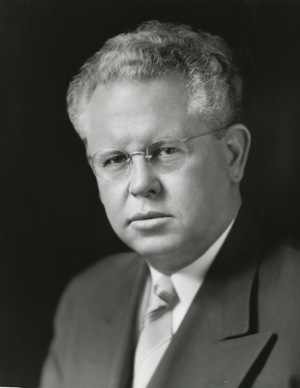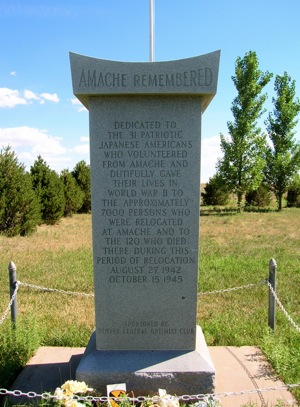"If you harm them, you must harm me. I was brought up in a small town where I knew the shame and dishonor of race hatred. I grew to despise it because it threatened the happiness of you and you and you."
With those words, then-Gov. Ralph Carr urged Colorado residents to do what many millions of Americans would not: tolerate, accept and support the thousands of Japanese-Americans being forcibly relocated to their state.
That speech in early 1942 – and Carr’s battles on behalf of Japanese-Americans – not only flew in the face of the anti-Japan hysteria that gripped the country following the attack on Pearl Harbor, it likely led to his defeat in his 1942 Senate campaign.
His efforts to grant Japanese-Americans a safe haven in Colorado are recalled in a documentary film co-sponsored by Nitto Tire USA Inc. The film was released earlier this year, premiering at the Japanese American National Museum in Los Angeles, and is now available for viewing on most All Nippon Airlines international flights.
Following three Japanese-Americans who lived in Colorado’s lone internment camp, the documentary provides perspective from each individual experience. In one of the stories, Robert Fuchigami tells of the deterioration of his family’s unity and the sadness endured by the more than 120,000 Japanese-Americans forced to give up their homes, lives and property to live in the 10 hastily erected “War Relocation Centers” from 1942-46.
Fuchigami hopes that others will never forget so that “these social injustices will never be repeated.”
The feature also includes two less common narratives, which are, in part, attributed to Carr. Herbert Inouye recounts his family leaving their California home and making the move to Colorado. He remembers angry citizens on the streets yelling slurs at their car and seeing soldiers with guns as they traveled east. Yet, after a harrowing journey, a state trooper at the Colorado state line warmly welcomed his family.
Similarly, Colorado native Mitchie Terasaki avoided the government evictions and internment faced by most Japanese-Americans, and led a successful life as a civil servant in the Colorado state government after being hired by Carr.
Strong Ties
“As a company with both American and Japanese roots, we felt we were uniquely positioned to make people aware of Ralph Carr’s story and how his life impacted so many Japanese Americans,” said Tomo Mizutani, president, Nitto Tire USA. “We are dedicated to telling this important cultural story and aim to prevent injustices like this from occurring in the future.
“There has been much triumph for Japanese in America, and some tragedy, too,” Mizutani added. “Thankfully, there were people like the late Gov. Carr, who provide us with examples of morality and decency even in the most trying of eras. We hope the documentary will help educate this and future generations of all ethnic backgrounds about what it truly means to be an ‘American.’ We at Nitto are honored to participate in this documentary.”
The documentary was a joint creation of Nitto and Fujisankei Communications International, the American subsidiary of Fujisankei Communications Group, a Japanese conglomerate of television and radio stations and magazine, newspaper, record and video game companies.
Nitto’s involvement in the production and broadcast of the documentary is part of the company’s “corporate social responsibility” efforts. “As a Japanese company doing business in the U.S., we believe that it is very important for us to return a portion of our gain to the U.S. community,” Mizutani said.
The film was inspired, he said, by a 2009 speech by Akemi Yano, the former CEO of the Japanese American National Museum. “Inspired by her speech, we started looking for a film producer,” he said.
After its formal launch in Los Angeles, the film was aired a few times last December on a Japanese cable station to viewers in Los Angeles, New York and Hawaii. The deal with ANA kicked off on Sept. 1.
Lesson From History
When America was drawn tragically into World War II, most Coloradans weren’t concerned whether Japanese-Americans should lose virtually all of their rights, but rather where the interment camps should be located. By and large, Colorado residents didn’t want any of the 10 planned camps in their state. And they made their feelings known with often crude, racist roadside signs and full billboards.
Carr publicly opposed the forced internment, saying that denying any group its Constitutional rights would put the rights of all Americans in jeopardy. However, Carr wasn’t going to win that Constitutional battle, not with public opinion so fiercely swayed, so he focused his attention on trying to make the confinement as comfortable as possible.
Just after the Pearl Harbor attack, President Franklin Roosevelt issued Executive Order 9066, which established the internment camps where Japanese-Americans from the West Coast would be sent until such time as their loyalty to the U.S. was satisfactorily proven. Japanese-Americas all along the West Coast and even more inland were rounded up and shipped off to “assembly centers” in California, Arizona, Washington and Oregon for processing and camp assignment.
People with as little as 1/16th Japanese ancestry were included. Those bound for relocation had as little as six days to dispose of their property (often at prices far, far below market value) and possessions, and their other financial assets were frozen by the government. Other than those volunteering for military service, few camp residents were allowed to leave, regardless of their loyalty to America.
Colorado was chosen for one of 10 camps; two others were in Arkansas, one each in Wyoming, Idaho and Utah, and four in eastern California, well away from the Pacific coast.
The Granada War Relocation Center (also known as Camp Amache) opened in August 1942, and by October of that year it had reached its capacity of 7,500 people. At its apex, Granada was Colorado’s 10th largest city.
As with the others, the Granada center was a small city ringed with heavy fencing and heavily armed guard towers. Located in the arid high plains, the camp had its own post office, hospital, schools and stores. But its residents lived in shared barracks with little or no family or personal privacy. The wood-frame buildings had concrete foundations, minimal walls and roofs, no insulation and floors of bricks set in dirt. Coal burning stoves provided heat. Living quarters were arranged in blocks of 12 barracks each, and residents had to eat military-style meals in large mess halls.
At the same time, Camp Amache had its own recognized Boy Scout Troop, Memorial Day parade and an undefeated high school football team. The team played against other Colorado high schools, but all of its games were played on its home field.
Carr Remembered
Carr died on Sept. 22, 1950 at age 61, but even as a one-term governor he is memorialized with a statue, and he remains well-remembered by the Japanese-American community. The camp was listed on the National Register of Historic Places on May 18, 1994, and designated a National Historic Landmark on Feb. 10, 2006.
The camp remained open and operating until a few months after the war ended in August 1945. Its buildings were then destroyed and removed, and 70 years later all that remains are cement foundations and the original water pumphouse. The rest has been covered over by vegetation and desert, and other than a historical marker, the one-time city of 7,500 Americans is but a memory.
But Camp Granada lives in the spirit of the famous future politicians, professors, photographers, actors, advocates, architects and even Medal of Honor winners who were once forced to call it home.













